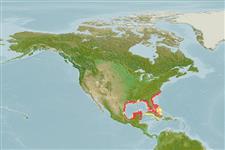Environment: milieu / Zona climática / intervalo de profundidade / distribution range
Ecologia
marinhas associadas(os) a recifes; intervalo de profundidade 0 - 30 m (Ref. 26938). Subtropical; 36°N - 18°N, 99°W - 75°W (Ref. 55283)
Western Atlantic: North Carolina, USA to the northern Gulf of Mexico and Yucatan, Mexico.
Tamanho / Peso / Idade
Maturidade: Lm ? range ? - ? cm
Max length : 75.0 cm TL macho/indeterminado; (Ref. 9710); 76.0 cm TL (female); common length : 60.0 cm TL macho/indeterminado; (Ref. 6077)
Elongate, with a heart-shaped disk terminating in a wedge-shaped snout with a few enlarged tubercles on tip (Ref. 26938). Ashy gray to olive brown or chocolate brown. Entire upper surface is thickly freckled with several hundred small whitish dots. Lower surface is pale yellow or yellowish white or plain white, fins slightly darker than trunk (Ref. 6902).
Body shape (shape guide): elongated.
Inhabits sandy and weedy bottoms, sometimes near patch reefs. Also found along beaches from shoreline to depths of 30 m (Ref. 26938). Usually buried in the sand or mud. Feeds on mollusks and crustaceans. Ovoviviparous, with up to 6 in a litter (Ref. 12951). Size at birth 20 cm (Ref. 12951). Generally uncommon (Ref. 9710).
Ciclo de vida ou comportamento de acasalamento
Maturidade | Reprodução | Desova | Ovos | Fecundidade | Larvas
Exhibit ovoviparity (aplacental viviparity), with embryos feeding initially on yolk, then receiving additional nourishment from the mother by indirect absorption of uterine fluid enriched with mucus, fat or protein through specialised structures (Ref. 50449).
Robins, C.R. and G.C. Ray, 1986. A field guide to Atlantic coast fishes of North America. Houghton Mifflin Company, Boston, U.S.A. 354 p. (Ref. 7251)
Status na Lista Vermelha da UICN (Ref. 130435: Version 2024-2)
Ameaça para os humanos
Harmless
Uso pelos humanos
Pescarias: pesca de subsistência
Ferramentas
Relatórios especiais
Baixar XML
Fontes da internet
Estimates based on models
Preferred temperature (Ref.
123201): 23.4 - 27.8, mean 26.3 °C (based on 280 cells).
Índice de diversidade filogenética (Ref.
82804): PD
50 = 0.5020 [Uniqueness, from 0.5 = low to 2.0 = high].
Bayesian length-weight: a=0.00282 (0.00134 - 0.00591), b=3.12 (2.95 - 3.29), in cm total length, based on LWR estimates for this Genus-body shape (Ref.
93245).
Nível Trófico (Ref.
69278): 3.6 ±0.50 se; based on food items.
Resiliência (Ref.
120179): Muito baixo(a), tempo mínimo de duplicação da população maior que 14 anos (Fec assumed to be <10).
Fishing Vulnerability (Ref.
59153): Moderate to high vulnerability (50 of 100).
🛈
Nutrients (Ref.
124155): Calcium = 12.2 [1.5, 49.3] mg/100g; Iron = 0.424 [0.102, 1.177] mg/100g; Protein = 20.1 [17.9, 22.2] %; Omega3 = 0.128 [0.053, 0.310] g/100g; Selenium = 11.3 [3.2, 35.3] μg/100g; VitaminA = 33 [11, 104] μg/100g; Zinc = 0.63 [0.30, 1.34] mg/100g (wet weight);
